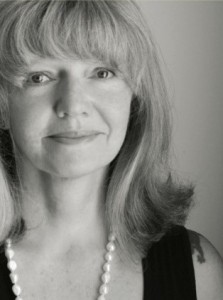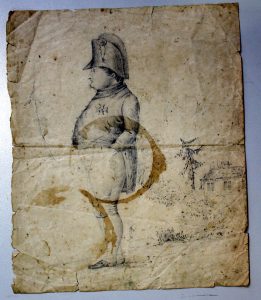‘AND LASTLY… ‘
‘AND LASTLY… ‘
For the last fifteen years, much of my research into the life and work of Georgiana Molloy has led me through beautiful gardens and wild expanses of natural bushland. I’ve caught my breath at the unexpected beauty of centuries-old, dried botanical specimens and I’ve shed tears on holding in my hand small pieces of paper with heartfelt words written on them that changed lives. I’ve spent more hours than I could count trying to immerse myself into the world of Georgiana Molloy and her family, reading contemporary books and documents, listening to music, staring at paintings and sculptures, trying recipes, even touching fabrics to imagine how they would have felt against my own skin as an item of everyday clothing. But the shadowy corners of that world are always there. I’ve always tried not to turn my face away from the dark side of her life, to face it full on and acknowledge it, but every now and again I’m reminded that her world was different in ways that do more than unsettle me. They horrify me.
On the voyage to the Swan River Colony (now Perth, Western Australia) the ship Warrior spent two weeks onshore in early 1830 at the Cape Colony/Cape of Good Hope, then a British colony in present day South Africa. Captain and Mrs Molloy enjoyed the company of the governor and his family, the other lords and ladies who were there, and spent a lot of time with the commandant of the British army garrison, who was an old friend and colleague of John Molloy.
The Government Gazette was the main local source of news for those who were interested in the births, deaths and marriages of the British colonists and for anyone who cared about who’d arrived, who’d left, and whether they travelled in an expensive cabin or roughed it in steerage with the crowds. This morning, in the edition for early 1830, I found the shipping notices of the arrival and departure of the Warrior and I did what I always do. I read everything else, especially the advertisements.
There were homes for sale, livestock and goods, a reward offered for news about a wayward son who’d absconded from home for the second time. There were others missing, too. Lists of names and descriptions of enslaved people who had managed to escape. And, littered casually among items for sale—prime Irish butter, cut glass—there were the names of human beings. On any page, the offerings for purchase slipped to and fro’ between livestock, household objects and men, women and children.
There are indications in her family history, and in her writing, that Georgiana Molloy had different views and values to most of her fellow colonists, but in 1830, when she must surely have read the same document I read today, the abolition of slavery in British colonies was still three years away. I have no way of knowing if her feelings of revulsion matched my own or whether the text in front of her seemed no more unsettling than the usual kind of news.
Here’s the advert that led me to write this post.
It was quite long so I’ve used extracts (the italics are mine) but please, read on until you reach the names. Enslaved, all of them, some second and third generations of enslaved families in the Cape Colony, others first captured in their home country, with personal memories of the freedom that was their human right. They were aged between seventy-three. Bacchus, a labourer, born in Mozambique, and Mietje, not yet two years old, a daughter of Alida. In the minds of those who ‘sold’ them and those who ‘bought’ them, they were of less interest than the goods, the possessions listed before them as part of the same family’s sale.
I’ve written several times about the way that slavery in British colonies has a way of turning up again and again in my ongoing research, whether I’m writing fiction or non-fiction, so today is not exceptional but, for some reason, finding this advertisement in the newspaper I was reading, and the words that writer used on that day nearly two centuries ago, has hit a harder punch than usual. I have a feeling you’ll understand.
Cape of Good Hope Government Gazette 1830 (Brenda Gassner)
https://www.eggsa.org/newspapers/index.php/cape-of-good-hope-government-gazette
AND FURTHER WILL BE SOLD,
On Monday the 15th February next… All the valuable and elegant Furniture of the Estate, consisting in Sofas, Dining Tables; …
Bedsteads and Bedding complete; Looking Glasses, Toilet and Pier Glasses, Clothes Presses, Sideboards and Cupboards, Wash-hand Stands, a large Carpet, a Clock, 2 Fowling Pieces, 4 large Bibles, and some other Books, &c. &c &c.
Plate and Plated Ware Silver Table Spoons, and Forks, 2 Soup Ladles, Tea Spoons, Fish Slices, &c. plated Candlesticks…
Crockery, viz: – A blue Dinner Service, complete; a green Dessert Service…
Cut Glass – Such as Decanters, Comfit Pots, Fruit Dishes, Beer and Wine Glass, &c. –Culinary Utensils, Copper Boilers, Kettles. &c.
…
Carriages, Waggons, and Farming Implements – Comprising a covered Horse Waggon, 2 Bullock Waggons, with Yokes complete; 2 open Horse Waggons…
Cattle – 7 Horses, 70 Cows and Calves, 80 Oxen, and 10 Pigs
AND LASTLY, the following clever male and female SLAVES, viz:
| Bacchus, of Mozambique, | Aged 73, | Labourer. |
| David of Madagascar, | 62 | do |
| Jupiter, of Mozambique, | 58 | do |
| Louis, (1) of ditto, | 47 | do |
| Frit, of this Colony, | 63 | do |
| Francois, of Mozambique, | 58 | do |
| Abraham, of ditto, | 43 | do |
| Izaak, of this Colony, | 37 | do |
| Mercuur, of Mozambique, | 43 | do |
| Saul, of ditto, | 43 | do |
| Constant, of ditto, | 48 | do |
| Philander, of this Colony, | 43 | do |
| Thelemachus, of ditto, | 48 | do |
| Salomon, of ditto, | 37 | Shoemaker |
| Florian, of Mozambique, | 29 | House Boy |
| Benjamin, of ditto, | 58 | Carpenter |
| Jephta, of Bengal, | 53 | Cook |
| Hercules, of Batavia, | 50 ½ | House Boy |
| Frederik, of the Colony | 17 | |
| Slammat, of ditto, | 16 | |
| Apollus, of ditto, | 14 | |
| Jan, of Java, | 63 | Mason |
| Esau, of this Colony, | 50 ½ | Taylor |
| Tulp, of Mozambique | 43 | Labourer |
| Jan, (2) of this Colony, | 9 | Child of Samida |
| Marie, of Madagascar, | 63 | housemaid |
| Mietje, (1) of Jave, | 53 | do |
| Alida, of this Colony,
(2) Mietje, |
21
aged 1 ½ year |
With her child |
| Mina, of ditto | 12 years and 4 months. | |
| Christia[an], of ditto, | 22 | |
| D[ ], of ditto, | 11 | housemaid |
| S[ ], of ditto, | [ ] | do |
| Lau[], of ditto, | 43 | do |
| D[ iana ], of ditto, | 23 | With her child |
| Florentina, | aged 2 years and 4 months. | |
| Rigina, of this Colony, | 46 1/2 | sempstress |
Image:
Thomas Whitcombe – View of Cape Town, Table Bay, Cape of Good Hope 1818
Thomas Whitcombe, Public domain, via Wikimedia Commons

